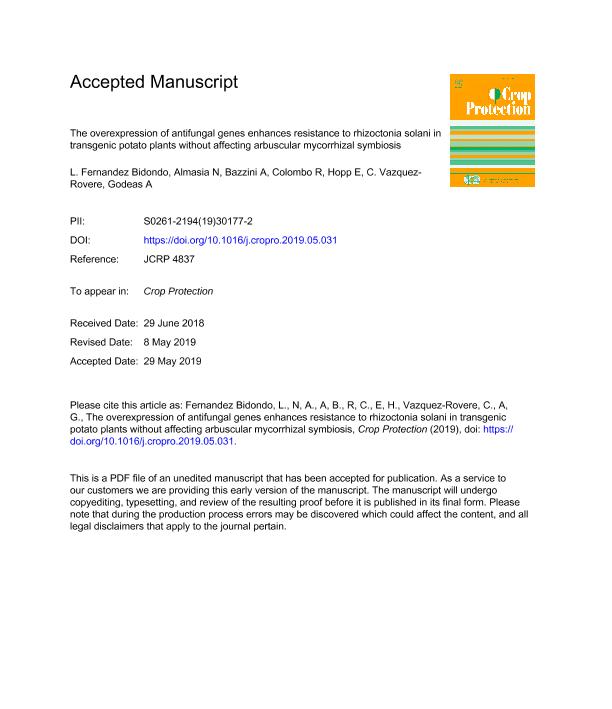Mostrar el registro sencillo del ítem
dc.contributor.author
Fernandez Bidondo, Laura

dc.contributor.author
Almasia, Natalia Ines

dc.contributor.author
Bazzini, Ariel Alejandro

dc.contributor.author
Colombo, Roxana

dc.contributor.author
Hopp, E.
dc.contributor.author
Vazquez Rovere, Cecilia

dc.contributor.author
Godeas, Alicia Margarita

dc.date.available
2020-11-25T13:36:44Z
dc.date.issued
2019-10
dc.identifier.citation
Fernandez Bidondo, Laura; Almasia, Natalia Ines; Bazzini, Ariel Alejandro; Colombo, Roxana; Hopp, E.; et al.; The overexpression of antifungal genes enhances resistance to rhizoctonia solani in transgenic potato plants without affecting arbuscular mycorrhizal symbiosis; Elsevier; Crop Protection; 124; 10-2019; 1-25
dc.identifier.issn
0261-2194
dc.identifier.uri
http://hdl.handle.net/11336/118937
dc.description.abstract
The biological control of fungal diseases through the use of genetically modified (GM) plants could decrease the input of chemical pesticides. To overcome possible losses in potato (Solanum tuberosum) yield because of susceptibility to soil fungal pathogens, researchers have developed potato transgenic lines expressing antifungal proteins. However, all GM crops must be monitored in their potentially detrimental effects on non-target soil microorganisms. Arbuscular mycorrhizal (AM) fungi are good candidates for this type of analysis, as good indicators of a normal rhizosphere structure and functionality. In this work, we have monitored potato lines with over-expression of genes encoding peptides with antifungal properties on their effects on the soil-borne fungal pathogen Rhizoctonia solani and AM fungi.The six GM potato lines (AG-1, AG-3, RC-1, RC-5, AGRC-8 and AGRC-12) evaluated showed higher reduction in infection indexes in comparison to untransformed plants when challenged with a highly virulent strain of R. solani. The growth of RC-1, RC-5 and AGRC-12 lines remained almost unaltered by the pathogen; which evidenced the maximum inhibition of R. solani infection. The level of root colonization by the AM fungus Rizophagus intraradices (pure in vitro isolated) did not significantly differ between transgenic and wild potato lines under in vitro and microcosm conditions. An increase in mycorrhization was evident with the addition of potato biomass residues of these GM lines in comparison to the addition of residues of the wild type potato line.In addition to the R. intraradices assays, we performed microcosm assays with soil samples from sites with at least100-year history of potato crop as inoculum source.The roots of AGRC-12 GM line showed significant higher levels of native mycorrhization and arbuscules development. In general, the potato lines apparently were less receptive to R. intraradices pure inoculum than to AM species from the natural inoculum. In this work, the selected GM potato lines did not have evident adverse effects on AM fungal colonization.
dc.format
application/pdf
dc.language.iso
eng
dc.publisher
Elsevier

dc.rights
info:eu-repo/semantics/openAccess
dc.rights.uri
https://creativecommons.org/licenses/by-nc-nd/2.5/ar/
dc.subject
TRANSGENIC POTATO
dc.subject
ANTIFUNGAL GENES
dc.subject
RHIZOCTONIA SOLANI
dc.subject
ARBUSCULAR MYCORRHIZAL FUNGI
dc.subject
INTRARADICAL VARIATIONS
dc.subject
TRANSGENIC POTATO
dc.subject
ANTIFUNGAL GENES
dc.subject
RHIZOCTONIA SOLANI
dc.subject
ARBUSCULAR MYCORRHIZAL FUNGI
dc.subject
INTRARADICAL VARIATIONS
dc.subject.classification
Micología

dc.subject.classification
Ciencias Biológicas

dc.subject.classification
CIENCIAS NATURALES Y EXACTAS

dc.title
The overexpression of antifungal genes enhances resistance to rhizoctonia solani in transgenic potato plants without affecting arbuscular mycorrhizal symbiosis
dc.type
info:eu-repo/semantics/article
dc.type
info:ar-repo/semantics/artículo
dc.type
info:eu-repo/semantics/publishedVersion
dc.date.updated
2020-11-20T14:48:29Z
dc.journal.volume
124
dc.journal.pagination
1-25
dc.journal.pais
Países Bajos

dc.journal.ciudad
Amsterdam
dc.description.fil
Fil: Fernandez Bidondo, Laura. Consejo Nacional de Investigaciones Científicas y Técnicas. Oficina de Coordinación Administrativa Ciudad Universitaria. Instituto de Biodiversidad y Biología Experimental y Aplicada. Universidad de Buenos Aires. Facultad de Ciencias Exactas y Naturales. Instituto de Biodiversidad y Biología Experimental y Aplicada; Argentina
dc.description.fil
Fil: Almasia, Natalia Ines. Instituto Nacional de Tecnología Agropecuaria. Centro de Investigación en Ciencias Veterinarias y Agronómicas. Instituto de Biotecnología; Argentina. Consejo Nacional de Investigaciones Científicas y Técnicas; Argentina
dc.description.fil
Fil: Bazzini, Ariel Alejandro. Instituto Nacional de Tecnología Agropecuaria. Centro de Investigación en Ciencias Veterinarias y Agronómicas. Instituto de Biotecnología; Argentina. Consejo Nacional de Investigaciones Científicas y Técnicas; Argentina
dc.description.fil
Fil: Colombo, Roxana. Consejo Nacional de Investigaciones Científicas y Técnicas. Oficina de Coordinación Administrativa Ciudad Universitaria. Instituto de Biodiversidad y Biología Experimental y Aplicada. Universidad de Buenos Aires. Facultad de Ciencias Exactas y Naturales. Instituto de Biodiversidad y Biología Experimental y Aplicada; Argentina
dc.description.fil
Fil: Hopp, E.. Instituto Nacional de Tecnología Agropecuaria. Centro de Investigación en Ciencias Veterinarias y Agronómicas. Instituto de Biotecnología; Argentina
dc.description.fil
Fil: Vazquez Rovere, Cecilia. Instituto Nacional de Tecnología Agropecuaria. Centro de Investigación en Ciencias Veterinarias y Agronómicas. Instituto de Biotecnología; Argentina. Consejo Nacional de Investigaciones Científicas y Técnicas; Argentina
dc.description.fil
Fil: Godeas, Alicia Margarita. Instituto Nacional de Tecnología Agropecuaria. Centro de Investigación en Ciencias Veterinarias y Agronómicas. Instituto de Biotecnología; Argentina. Consejo Nacional de Investigaciones Científicas y Técnicas; Argentina
dc.journal.title
Crop Protection

dc.relation.alternativeid
info:eu-repo/semantics/altIdentifier/url/https://linkinghub.elsevier.com/retrieve/pii/S0261219419301772
dc.relation.alternativeid
info:eu-repo/semantics/altIdentifier/doi/http://dx.doi.org/10.1016/j.cropro.2019.05.031
Archivos asociados
